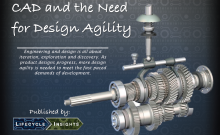Engineering teams need to respond to many challenges when developing products, especially in a dynamic, competitive environment. Design engineers must respond quickly to project or bid proposals, rapidly generate design concepts or make late-stage changes to the product based on customer or supplier input.
To save time, you can leverage existing 3D CAD models and modify them. If you don’t know how the model was built or if the model lacks design intent, the process can be time-consuming and frustrating – one that will likely require you to rebuild the model from scratch.
Design intelligence and the need for flexible modeling
You need the power to make late-stage design changes quickly and easily, without sacrificing existing design intent. You need the ability to rapidly recognize features and patterns in imported models, enabling seamless modifications. You need to be nimble and agile in your modeling: making direct edits, preserving the intelligence of existing models and applying intelligence to dumb models. You need design agility.
In the video below, Brian the 3d Engineering Wonderkid talks about the challenges of late stage design changes.
In his series of new eBooks, industry analyst/blogger Chad Jackson, explores how today’s newest technology can help leverage the power of parametric with the flexibility of agile design.
Chad explains that over the past few years, several new technologies have emerged in the CAD industry that are innovative and can have an impact on design and engineering. Here are the three that are most critical to design agility.
• The ability to enable direct changes including push, pull and drag interactions to be used to
modify parametric feature-based models. This capability provides more design agility.
• However, given the importance of parametric feature-based models, the ability to record direct modeling changes of parametric feature-based models is critical. This enables organizations to improve design agility but also preserve the work they have done with parametric feature-based approaches.
• When working with imported models, the ability to recognize the inherent intelligence that exists in geometry is critical to design agility. Users can make changes without investing significant time to recreate the model.
Creo Flexible Modeling Extension
Increased flexibility, even for wide-scale modifications late in the design stage, and the ability to modify 3D CAD modeling data while in a parametric model is now an achievable possibility. The Creo Flexible Modeling Extension (FMX) introduced by PTC in 2011 allows Creo Parametric to become increasingly flexible for designing and accelerates the user’s ability to answer any difficulties in design. With Creo 2.0, the flexibility has been increased even further!
Key Benefits
• Easy to use and learn. Intuitive, direct interaction with geometry helps you get up to speed quickly and easily edit 3D designs from any 3D CAD model
• Original design intent is preserved – and your edits are captured as features that can be further modified in the future
• Easily accommodate late-stage changes to your engineering design faster and with less frustration with this flexible modeling approach
• Work more efficiently in a multi-CAD environment by easily incorporating and editing data from other CAD systems. You can also add parametric design intent to imported data
• Faster, more flexible 3D editing increases the efficiency and productivity of detailed design and downstream product development process
Click below to download Chad's eBook on Design Agility, and visit our Products Pages for more information on Creo Products!
